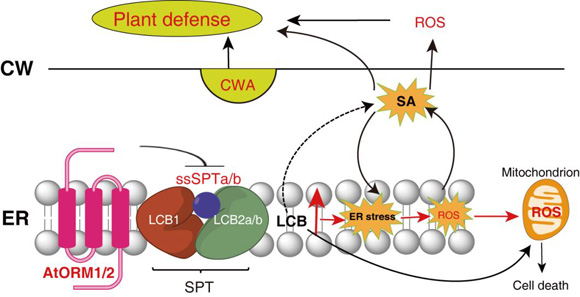Research Advancement in Understanding the Regulation of Plant Sphingolipid Biosynthesis
Source: School of Life Sciences
Written by: School of Life Sciences
Edited by: Wang Dongmei
Recently, a research article entitled “Orosomucoid Proteins Interact with the Small Subunit of Serine Palmitoyltransferase and Contribute to Sphingolipid Homeostasis and Stress Responses in Arabidopsis” has been published online in
The Plant Cell, one of the top journals in plant field (impact factor 10.529). This study led by Prof. Nan Yao from School of Life Sciences at Sun Yat-sen University unraveled the importance of regulation of plant sphingolipid biosynthesis and the role of sphingolipids in plant development and immune responses.
Sphingolipids are essential components of cellular membranes and play pivotal roles as bioactive molecules involved in signal transduction and cell regulation, and in a wide range of other biological processes, including secretion, programmed cell death, autophagy and stress responses (Bi et al., 2014; Wu et al., 2015). Serine palmitoyltransferase (SPT) is the first and rate limiting enzyme in sphingolipids synthesis which is regulated by orosomucoids (ORM) proteins in human and yeasts. However, the function of ORMs is not well understood in plants. They found that plant ORMs physically interact with the small subunit of SPT (ssSPT) and inhibit SPT complex activity. Ablation of ORMs stimulated the de novo sphingolipid biosynthesis, enhanced resistance to oxidative stress and pathogen infection and exhibited an early senescence phenotype. This study indicates that ORMs interact with SPT to regulate sphingolipid homeostasis and play a pivotal role in environmental stress tolerance in plants.

The original article link:
http://www.plantcell.org/content/early/2016/12/06/tpc.16.00574.full.pdf+html
References (*Corresponding author)
Bi, F-C., Liu, Z., Wu, J-X., Liang, H., Xi, X-L., Fang, C., Sun, T-J., Yin, J., Dai, G-Y., Rong, C., Greenberg, J.T., Su, W-W., and Yao, N.* (2014) Loss of ceramide kinase in Arabidopsis impairs defenses and promotes ceramide accumulation and mitochondrial H2O2 burst.
Plant Cell, 26:3449-3467.
Wu, J-X, Li, J., Liu, Z., Yin, J., Chang, Z-Y., Rong, C., Wu, J-L., Bi, F-C. and Yao, N.* (2015) The Arabidopsis ceramidase AtACER functions in disease resistance and salt tolerance.
Plant Journal, 81, 767–780.
